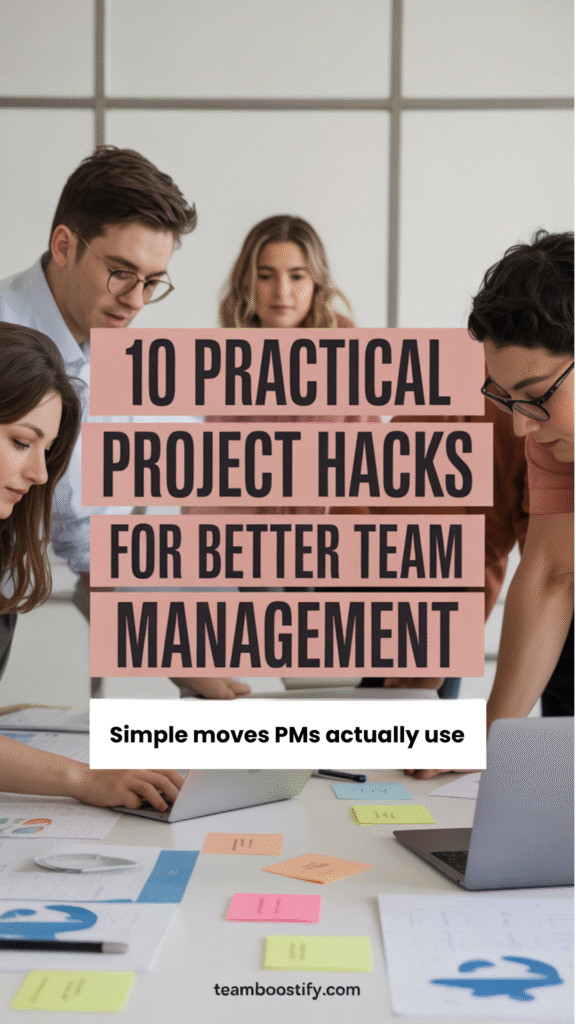I can talk about project management for hours, but let’s keep it short. This post is a quick digest of project hacks I use actively. Simple, practical, and tested – 10 project hacks that help deliver projects together with the project team. In my experience, it’s rarely easy, but always engaging.
Table of Contents
Project Hacks 1/10: Set Clear Goals (The Power of “Why”)
Goals are more than a list in the project charter. Deliverables matter, but they don’t keep a team motivated under pressure. People commit when they understand why the project matters — for the business, the client, or real users. That shared purpose is what carries a team through delays and shifting priorities.
PM Hacks
Here’s the catch: if you want your team to really get the “why,” you need to get it yourself first. Sounds obvious, but it’s not always easy.
In my experience, the best way to do that is to stay close to your sponsor and the key stakeholders. And yes, sometimes you’ll discover their “goals” don’t actually match. Messy, but normal. The earlier you spot that gap, the greater your chance is to fix it before it escalates into something painful for the entire project team.
Project Hacks 2/10: Define Roles & Responsibilities
Unclear ownership quickly creates delays and frustration. A detailed RACI — who’s Responsible, Accountable, Consulted, and Informed — cuts confusion and keeps tasks from falling through the cracks. With sign-off, it becomes the single source of truth for everyone.
PM Hacks
From my experience, there are two hacks worth fixing in your process.
First — don’t overload the RACI with micro-details. Instead, prepare a detailed description of functional responsibilities for each role in the project’s organizational structure. This way, RACI stays clear and manageable, while the nuances are documented separately.
Second — be ready for “orphan tasks.” These are activities no one thought to include in scope or assign to a role, but the project can’t move forward without them. I had this case on a SAP Payroll rollout: when we reached the stage of creating system roles for end users, we discovered HR roles from a previous implementation had to be reworked first. Without it, we were stuck. The lesson: keep a risk buffer (budget + procedure for approval) for unexpected tasks that don’t belong to anyone but are critical for delivery.
Project Hacks 3/10: Foster Open Communication (No Surprises)
Open communication is harder than it sounds. The real job of a PM is to build a safe space where people raise risks and problems early — without fear of blame. That honesty prevents last-minute escalations and keeps projects predictable.
PM Hacks
In my experience, the real booster for open communication is informal touchpoints — coffee breaks, quick chats, those moments outside the agenda where people feel safe to open up. Regular 1:1 conversations work the same way: they surface concerns people might never raise in a team meeting. And just as important is building the mindset that any team member can ping you in a messenger or call you directly. That accessibility sends a strong signal: problems are better shared early than hidden.
Project Hacks 4/10: Build Trust & Accountability
Trust and accountability sound simple but require consistency. Trust means relying on others to deliver; accountability means owning both the outcome and the process. Without them, even the strongest plan will collapse.
PM Hacks
When you’re a PM, you’re holding the whole picture in your head — plus 550 little details that could derail it. It’s easy to forget that for team members, some of those details aren’t top of mind, and things can get missed. That’s why a visible task tracker with reminders is a must.
But here’s the key: a tracker won’t ask the right questions for you. To set realistic deadlines, you often need to walk a team member through a chain of logical questions: What dependencies are there? Any approvals needed? This isn’t about distrust — it’s about making sure the commitment date reflects the real workload, not an optimistic guess. That way, accountability is fair and deadlines are achievable.
Project Hacks 5/10: Encourage Collaboration
Collaboration is what turns a group of specialists into a real project team. True collaboration is about sharing context, solving problems together, and making sure information flows across functions — not just up and down the reporting chain.
PM Hacks
In my experience, the quickest way to boost collaboration is to design for it, not just hope it happens. Use shared boards or project rooms where work is visible to everyone. Run joint sessions when tasks cross team boundaries, so people solve issues together instead of bouncing them back and forth.
And don’t underestimate the small rituals: weekly syncs, cross-updates, even quick show-and-tells of progress. They might feel lightweight, but they build trust and keep knowledge flowing. Over time, those habits dissolve silos and keep the team moving as one.
Project Hacks 6/10: Motivate & Recognize Efforts
Motivation and recognition are part of the PM’s job. It’s easy to think, “we’re all adults, we’re paid for this,” but the real need depends on team maturity. On one of my projects, department heads were both stakeholders and part of the project team, so recognition was less about cheerleading and more about aligning leaders and acknowledging their dual role.
PM Hacks
From my experience, two simple practices make a big difference:
First — praise people not only for results, but also for effort and support. And do it publicly, not just one-on-one. Public recognition sets the tone for the whole team and reinforces positive behavior.
Second — start a simple register at the beginning of the project where you log notable achievements (and failures) for each team member. By the time you reach an evaluation at the end of a phase or the full project, you won’t waste hours trying to recall details. You’ll have a fair, concrete record to work with.
Project Hacks 7/10: Manage Time Effectively
Time management in projects isn’t just about meeting deadlines — it’s about protecting the team’s focus. When everything is “urgent,” priorities blur, quality drops, and people burn out. A PM’s job is to set realistic timelines, defend them from constant shifts, and make sure effort is spent where it brings the most value.
And then there are project meetings — a separate story. Teams often feel like they spend more time in meetings than actually working. The fix is simple in theory but tricky in practice: use facilitation techniques so that project meetings are short, structured, and useful instead of draining.
PM Hacks
From my experience, two habits help a lot:
First — use visible timeboxes. Limit meeting lengths, fix sprint durations, and keep task estimates transparent. When time is framed clearly, it’s harder for distractions to creep in.
Second — stress-test deadlines with the team. Ask the extra questions about dependencies, handovers, or resource bottlenecks before committing. This way, people sign up to dates that are achievable, not just optimistic guesses. A realistic plan beats a “perfect” one that collapses in week two.
Project Hacks 8/10: Resolve Conflicts (Quickly)
Conflicts are normal in projects — different priorities, resource limits, and personalities will always clash. What hurts delivery isn’t the conflict itself, but leaving it unresolved. A PM’s job is to surface tensions early and deal with them before they block progress or damage trust inside the team.
PM Hacks
From my experience, a few things help:
First — act fast but stay neutral. Don’t wait for “small issues” to disappear on their own; they usually grow. Step in early, frame the issue around the project goals, and keep personal judgments out of it.
Second — focus on solutions, not blame. A quick joint session where each side lays out facts and constraints often uncovers a middle ground. Even if compromise takes time, people respect the process when they see the PM is fair and focused on moving the project forward.
Third — not every conflict gets resolved instantly. Sometimes you just have to account for it. For example, when planning meeting participants, you may need to separate certain people to keep the session productive. Not ideal, but that’s real life.
Project Hacks 9/10: Support Continuous Learning
Strong teams don’t just deliver — they evolve. A project without reflection risks repeating the same mistakes, while a team that learns builds speed and resilience over time. Continuous learning isn’t about running big training programs; it’s about creating small, regular moments where the team can pause, review, and improve.
PM Hacks
From my experience, three practices make learning part of the workflow:
First — run short retros at the end of key phases or sprints. Keep them focused: what worked, what didn’t, what to change next time.
Second — create space for peer sharing. Even a 15-minute “show and tell” on how someone solved a problem saves others from reinventing the wheel.
Third — log lessons learned as you go. Waiting until project closeout usually means the best insights are forgotten. A living document helps capture both wins and failures while they’re fresh — and gives the next project a head start.
Project Hacks 10/10: Lead by Example
Teams watch what you do more than what you say. Leadership in projects isn’t about fancy speeches — it’s about setting the tone through daily behavior. If the PM cuts corners, hides mistakes, or shifts blame, the team will do the same. But if you show accountability, transparency, and calm under pressure, people will mirror it. If you need some inspiration, check out my collection of quotes about leaders and teams — they capture this principle perfectly.
PM Hacks
From my experience, three habits matter most:
First — follow through on your own commitments. If you promise to escalate, update, or deliver something, do it. Nothing builds credibility faster.
Second — model the behavior you expect. Want transparency? Share your own challenges openly. Want accountability? Own your slip-ups.
Third — stay consistent under pressure. Even if you can’t solve the problem immediately, showing steadiness helps the team focus on solutions instead of panic. Your behavior becomes the blueprint for how the team handles stress.
These 10 project hacks aren’t theory – they’re small moves that keep projects moving when things get messy. Try them out, adapt them to your context, and you’ll see how much smoother teamwork becomes. In the end, it’s the simple project hacks that usually make the biggest difference.
If you found this useful, you might also like:
- 10 Project Management Top Skills for PMs to Stay Valuable
- 15 Practical Work From Home Productivity Criteria for PM
And if you want more practical ideas like these, I share them regularly on Pinterest — you can follow me at @Julia_PM_Facilitator.


